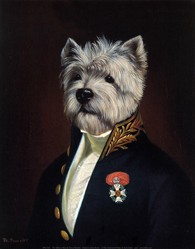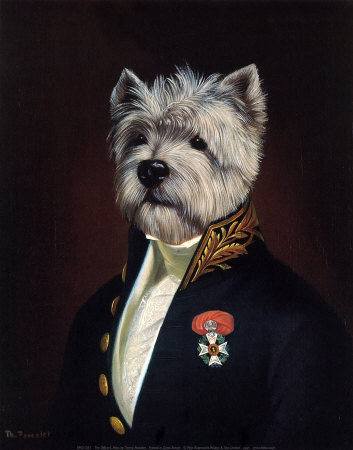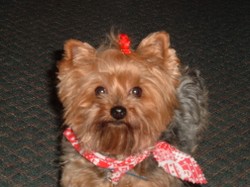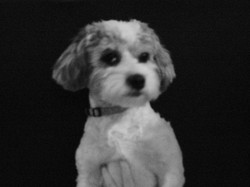The West Highland White Terrier is what I call a “real dog” among the small dog breeds. Originating in Scotland it is also known under the names (White) Roseneath Terrier or Poltalloch Terrier. Fans of this breed refer to them also often as Westies or Westys. I have collected here a lot of information about this breed to help you to decide if the Westie is right for you and your family and to help you deciding if your next puppy should be a West Highland White Terrier or not. Another intention of this article is also to help to distribute more information about this wonderful and enchanting small dog breed.

The West Highland White Terrier
by Sam
History and breed information about the West Highland White Terrier. Is the Westie the right dog for you? Read on to find out!
Origin and history of the West Highland White Terrier
Many legends exist to explain the origin of this all white short-legged terrier breed. The most well-known one goes like this:
One day Colonel Edward Donald Malcolm from Poltalloch (Argyllshire) in Scotland was hunting with his pack of terrier dogs and some friends. One of his dogs, one that had a red coat, suddenly jumped out of the undergrowth and was mistaken for a fox and unfortunately shot by one of the hunters during the heat of the hunt. Colonel Malcolm decided on the spot to breed only white dogs in future and so to avoid that they could be mistaken for a fox and being shot during a hunt. Other sources point to the 8th Duke of Argyll (the head of the Campbell Clan) as the original breeder with a similar story.
Like always, legends sound more interesting than the truth ;-) Fact is that the Westie originated in the middle of the 19th century in Scotland. The breed goes back to a litter of Cairn Terriers born in Argyll that included some all-white puppies. Selective breeding amongst those puppies let than to the development of the breed that we call now the West Highland White Terrier.
But white Westies were not only bred for their attention calling coat, but also as working dogs that helped to keep the land clear from rats, foxes, otters, badgers and animals that were considered vermin at that time. The were also valuable assistants in the hunt of small game such as rabbit and hare.
In 1907 the breed was officially recognized by the breeding authorities at Crufts dog show in England. The first American club was founded in 1909 and is called until today the “West Highland White Terrier Club of America” and is a member of the American Kennel Club. This dog breed was first called “(White) Roseneath Terrier” or “Poltalloch Terrier” but the name was changed early on to reflect better the origin of the breed.
Use of the West Highland White Terrier today
Often kept as a companion dog he also excels in dog sports like agility. The Westie needs a lot of exercise and “something to do”, so dog sports and agility training are ideal methods to keep this “little real dog” out of mischief. The Westie is also widely used in publicity and branding, many may know its' distinctive face from advertisement campaigns for Scottish Whisky and a certain brand of dog food.
Look and appearance of the West Highland White Terrier
The Westie is a sturdy little fellow with a compact built, a deep chest, a muscular appearance and an all-white double coat. Males have an average shoulder height of 9-12 inches (23-30 cm) and between 15-22 pounds (7-10kg) of weight. Bitches are smaller with an average shoulder height of 9-11 inches (23-28 cm) and a weight between 13-16 pounds (6-7.5kg)
The Westie is covered by his name-giving coat which can grow to over 2 inches in length. The coat is a so-called “double coat” consisting of a short, soft and dense undercoat, the insulation, and a rougher outer coat which protects against rain. A few Westies lack this top coat and have only the silky and very smooth undercoat. All Westies have in common that they don't shed their coat like many other dog breeds and they therefore need regular grooming.
Their eyes are dark and deep in the skull with often a curious and or penetrating look in them. Together with the pointed and erect ears, the Westie seems to carry always a mischievous expression. The tail, often pointing in excitement to the sky, is around 5-6 inches (13-15cm) long and shaped in the form of a carrot. Breed standards, together with common sense and the law in many countries, tell us that it never should be docked. The jaws are muscular and have the so-called "scissors bite” where the lower fangs are locked in front of the upper fangs and the upper front teeth are locked over the lower front teeth forming an effective pair of scissors when biting or gripping something with their teeth. The bones of a Westie are rather strong for its size and its paws show a slight webbing, making them good, and enthusiastic swimmers. The average life expectancy is more than 15 years.
Common Health Problems of the West Highland White Terrier
The Westie is normally a quite healthy breed, but some dogs may suffer from chronic, dry skin problems, skin irritations and allergies, hip problems (Perthe's disease), hernias, liver problems and
Craniomandibular osteopathy (jawbone calcification)
Craniomandibular osteopathy or juvenile jawbone calcification is an inherited disease that is also known under the name “lion jaw”. To inherit this disease, a puppy must have parents that are both carriers of the affected gene. There is at the moment no screening available to see if a dog or a bitch is a carrier, only when puppies develop this disease the breeder knows that both parents have to be taken out of breeding.
The first symptoms normally appear when the puppy is around 3-6months old and disappears spontaneously after an age of 12 months has been reached. Symptoms include, but are not restricted to, signs of discomfort and pain in the region of the jaws and the skull. This pain is caused by excessive bone deposition in this area. Craniomandibular osteopathy is not a cancer or an inflammatory disease but a genetic defect whose symptoms disappear after the first year of life of the affected puppy. The diagnosis is made with the help of radiography and the treatment consists mainly in cortisone, painkillers and in waiting. Craniomandibular osteopathy is very painful for the puppy and can lead to the refusal to eat and to being seriously underweight because of that. In very few cases euthanasia is necessary.
Temperament and behavior of the West Highland White Terrier
West Highland White Terriers are always game for action and are easy trainable. They are friendly creatures and love, most, children. They see themselves as “real” dogs and will take their stance against a much bigger dog when they think they were provoked. They love to hunt and to chase and that not only includes rodents but also the neighbours' cat. They are lively and need regular exercise and tasks so as not to become bored and destructive. They don't like to be left alone. They need a firm hand and the humans in the pack have to know how to exercise their leadership rights. Don't ever let your Westie become the pack leader - you would have to face serious behavioral problems such as food aggressiveness and biting! A Westie is great fun to have around, but they are not exactly a beginners dog. They do need a firm hand and some good “doggie knowledge”. They love to be the “watch dog” and they are good at it, unfortunately for your neighbors, they also love to bark at the slightest disturbance. They have to be trained from an early age to restrict this kind of behavior if you are living in a flat or condo. Westies like to travel, to be carried and spoiled and they are always up for something new.
Living Conditions a West Highland White Terrier needs
A Westie can live, and be happy, as well as in a city flat as in a country house, provided he gets enough exercise. But their ideal living quarters would be a country house with a large, fenced off garden, where they can roam free and can chase rodents.
Care and Grooming of a West Highland White Terrier
Weekly grooming with a simple, stiff dog brush and a trim of the long hairs around eyes and ears, to keep them free from obstructing hair, is all what the Westie needs for regular “maintenance”. They don't need a regular bath, unless you live in a very hot and humid climate. 3-4 times a year your Westie will need a hair cut and two times a year a so-called “stripping”, the removing of dead outer coat hair by hand. The grooming costs must be figured in when thinking of getting a West Highland White Terrier. If it is necessary to bath your Westie, you should do this only by using a special, moisturizing dog shampoo due to the fact that they tend to have dry skin problems. The ears have to be cleaned weekly, don't use cotton buds or q-tips - use a cotton ball dipped in special dog ear wash.
The West Highland White Terrier and other dogs and pets
Westies can be kept together with other dogs and pets, but you should always consider their hunting past and instincts. A Westie and a pet rat might not be the ideal pet combination! The easiest way to get such a mixed pet situation working is, if all pets are young when brought together. The next best method is when one of the pets is a minor and the least, most stressful method for all involved, is when all pets are grown up and settled into their ranks in the pack.
West Highland White Terrier and human allergies
Westies are a non-shedding breed and therefore ideal for people with allergy problems. Nevertheless, if you, or a member of your family, suffers under severe allergy attacks you should ask your doctor or GP to test you for allergic reaction to this particular dog you want to make a member of your household. This can avoid a lot of heart break and avoids that you have to give away the puppy or dog because your allergic reactions are too bad.
Breeds that are related to the West Highland White Terrier
The West Highland White Terrier belongs to the group of Scottish short-legged terriers which includes also the following breeds: Scottish terrier, the Skye terrier, the Cairn terrier and the Dandie Dinmont terrier.
Is the West Highland White Terrier the right dog for you?
If you are a single person that works each day over time in his or her job and has little to no dog experience, than probably not. If you are a semi-experienced dog owner, or are willing to become one by joining a puppy club or the like, and have enough time to exercise your dog then you might enjoy the company of the mischievous Westie. They are great dogs to have around and really behave like “real dogs” when trained properly. If you are an experienced, previous big dog owner that now happens to live in circumstances that are not apt for having a big dog, they might be even the ideal breed for you! When considering the possibility of owning a Westie, don't forget to figure in the additional costs for grooming. The West Highland White Terrier is also a breed you should consider if you are allergic to other, shedding, dog breeds.
You might also like
Cute Yorkie Pictures and Yorkshire Terrier ArtI took Yorkie puppy and dog pictures from the time our Yorkshire Terrier was ...
What Kind of Dog is a Teddy Bear?A teddy bear is a designer breed dog that resembles a teddy bear. Come take ...






 How to Choose the Topic for your First Bookon 12/17/2012
How to Choose the Topic for your First Bookon 12/17/2012
 Why I published my first book on Amazon - and you should too ;-)on 11/30/2012
Why I published my first book on Amazon - and you should too ;-)on 11/30/2012
 What to do with Kids in Prague - Go To the ZOOon 10/30/2012
What to do with Kids in Prague - Go To the ZOOon 10/30/2012
 Choco Story Museum - Things to do with Kids in Pragueon 10/30/2012
Choco Story Museum - Things to do with Kids in Pragueon 10/30/2012



Comments
Yes, they are very cute, but quite a handful also! Real dogs in a small package as I always say ;-)
I dog sit a terrier who is part westie for a friend - he's a stroppy little guy - which I believe is typcial! But very, very cute!